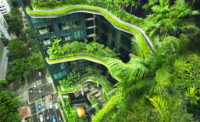Sandy, Oregon
In a town of just 8,000 people, a 310,000-square-foot building is a big deal, especially if it's the new high school. But such a project could easily overwhelm a rural town like Sandy, Oregon, halfway between Portland and historic Timberline Lodge on Mount Hood. So the design team at Dull Olson Weekes Architects'IBI Group (DOWA-IBI) broke the mass of the building into a number of pieces and tucked them into the sloping, wooded site. The architects also employed a broad range of sustainable-design strategies that reduce the school's carbon footprint and tie it to the environmental ethos of the Pacific Northwest.
'It's a big building in a small town,' says John Weekes, one of the firm's principals, 'and we wanted it to fit in.' Thirty miles from Portland, Sandy High School draws its 1,400 students from a sprawling, 425-square-mile district that encompasses national forests and scrappy farming towns where money is often tight. The steel-frame building opened in the fall of 2012 to replace a 90-year-old facility down the road that was cramped and outdated.
The challenge was to fit the project into its physical, environmental, and social context. The architects started by organizing the school as if it were an ancient Roman town'with two axes at right angles and the most public spaces at the intersection. One axis runs north'south and serves as a corridor linking shared elements such as a gym, an auditorium, and a dining 'commons' that are sometimes open to the public. A 600-foot-long east'west axis takes students and faculty from the public areas to a trio of classroom wings extending out to the south and to a double-height library to the north. The 82-acre site drops 80 feet from east to west, so the architects stepped the long student axis and the classroom wings down the slope. As a result, each of the school's four floors has direct access to the outdoors and hugs the hill. By reducing the amount of excavation needed, the scheme also saved the client several million dollars, says Jerry Waters, the senior designer for DOWA-IBI on the project. And by wiggling the classroom wings between existing trees, it preserved the wooded character of the site.
The local development code requires new buildings to follow a loosely defined 'Sandy style,' which incorporates elements of Cascadian architecture such as the pitched roofs and heavy timbers found at Timberline Lodge. Instead of borrowing such things literally, DOWA-IBI adapted them'for example, in the form of a sawtooth roof over the gym and wood louvers that block the sun on the classroom wings.
The architects pursued an aggressive environmental agenda in designing the school, using both passive and active solar strategies. 'The building needed to live in nature, just as the people around here do,' says Weekes. So in addition to pushing much of it up against the hill for protection against heat and cold, DOWA-IBI installed a 300-kilowatt photovoltaic solar array on the roof, along with a solar preheat system for hot water. Green roofs top two of the classroom wings, and a 500,000-gallon rainwater-storage tank supplies water for irrigation and toilets. A 3-mile-long loop of geothermal piping runs beneath the athletic fields, providing heating and cooling, while a displacement-air system moves air up and out so germs don't hang around and infect other people.
Daylighting is another important factor in reducing the building's energy use. The school's distinctive sawtooth roof brings sunlight into the gym through long clerestories, and large skylights along the student axis do the same there. All the classroom wings have single-loaded corridors lined with glazing, and classrooms themselves have plenty of windows looking both outside and into the corridors. So even on a rainy late-November afternoon, there were few electric lights on in most parts of the school. Where shading is needed, the architects used deep overhangs and a combination of vertical and horizontal cedar louvers. Overall, the building will perform about 54 percent more efficiently in terms of energy use than the Environmental Protection Agency's baseline for high schools in this area, says Waters.
To break down the learning areas into smaller sections, the architects created two 'cabins' in each wing and placed a small block of teachers' offices between them. Each cabin consists of four or five classrooms clustered around an open 'extended-learning area.' This arrangement offers teachers the chance to combine classes in the more casual extended-learning areas and students the opportunity to hang out there between classes. Each wing ends with a large space for learning practical skills such as automobile repair or agriculture.
Tim Werner, Sandy's principal, says everyone is still getting used to the new building. While students and staff have to walk farther now, since the school is twice the size of the old one, they appreciate all the daylight and impressive facilities like the gym and the double-height library, he adds.
Getting from one end of the school to the other may be a bit of a hike, but the building's strong relationship to the land makes it feel almost like a walk in the woods. That's not only good for the body, but good for the environment.
Completion Date: August 2012
Gross square footage: 310,000 square feet
Total construction cost: $75.4 million
Architect:
Dull Olson Weekes –IBI Group Architects, Inc.
907 SW Stark Street
Portland, OR 97205
Ph 503 226.6950
Fax 503 273.9192
PeopleOwner: Architect: Personnel in architect's firm who should receive special credit: Interior designer: Dull Olson Weekes –Jerry Waters, AIA; Nancy Rad, AIA IIDA Engineer(s): KPFF consulting engineers, Interface Engineering Consultant(s): Lighting: Interface Engineering Acoustical: Altermatt Associates Other: PLA Designs -theater General contractor: Hoffman Construction Company Photographer(s): Josh Partee CAD system, project management, or other software used: AutoCad, SketchUp |
ProductsStructural system Manufacturer of any structural components unique to this project: Knife River -structural, insulated precast concrete panels (carboncast) Exterior cladding Doors Interior finishes Special interior finishes unique to this project: perforated plywood panels Energy |












Post a comment to this article
Report Abusive Comment